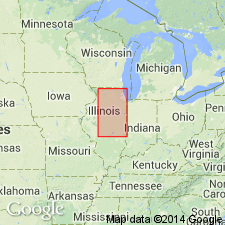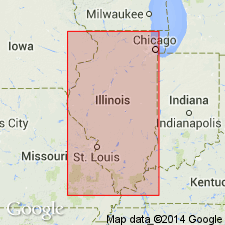
- Usage in publication:
-
- Dolton Member
- Modifications:
-
- Original reference
- Dominant lithology:
-
- Sand
- AAPG geologic province:
-
- Michigan basin
Summary:
Pg. 74-75; Illinois Bull., no. 95, p. 227, 1975. Dolton Member of Equality Formation. Lacustrine deposits, dominantly sand with local beds of silt and gravel, 8 feet thick. Age is Pleistocene (Wisconsinan Stage; Altonian Substage).
Type section: at top of clay pit, in S/2 NE/4 sec. 3, T. 36 N., R. 14 E., Cook Co., northeastern IL. Named from village of Dolton, Cook Co., northeastern IL.
Source: Publication; Hdbk Illinois stratigraphy (Illinois Geol. Survey Bull. 95, p. 227); US geologic names lexicon (USGS Bull. 1520, p. 86).

- Usage in publication:
-
- Dolton Member†
- Dolton facies (informal)*
- Modifications:
-
- Abandoned
- AAPG geologic province:
-
- Michigan basin
Summary:
Pg. 16, 18, 57, 60, 63-64, 82, 101. Dolton facies (informal) in Henry Formation of Mason Group. Consists of stratified sand and gravel sediments previously included in the Dolton Member of Equality Formation and Ravinia Sand Member of Lake Michigan Formation by Willman and Frye (1970). Overlies Lake Michigan Member of Equality Formation [=upper Lake Michigan Formation of Foster and Coleman, 1992, USGS I-map 2202]. Interpreted to be of nearshore lacustrine origin. Age is Pleistocene (Wisconsinan Age; Woodfordian Subage), based on radiocarbon dating, and part is considered Holocene.
Source: Publication.
For more information, please contact Nancy Stamm, Geologic Names Committee Secretary.
Asterisk (*) indicates published by U.S. Geological Survey authors.
"No current usage" (†) implies that a name has been abandoned or has fallen into disuse. Former usage and, if known, replacement name given in parentheses ( ).
Slash (/) indicates name conflicts with nomenclatural guidelines (CSN, 1933; ACSN, 1961, 1970; NACSN, 1983, 2005, 2021). May be explained within brackets ([ ]).

